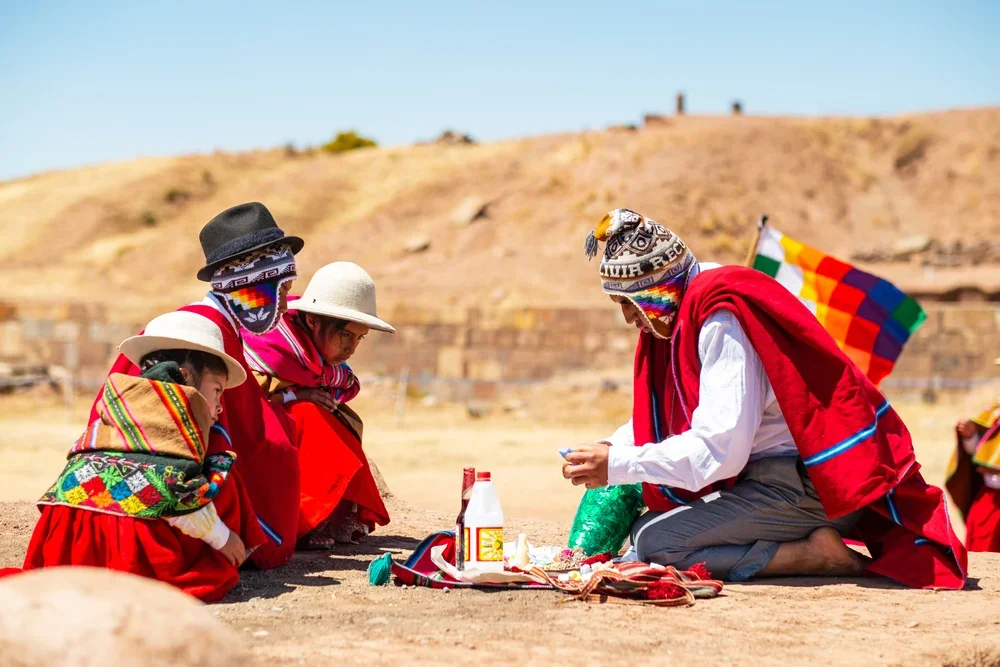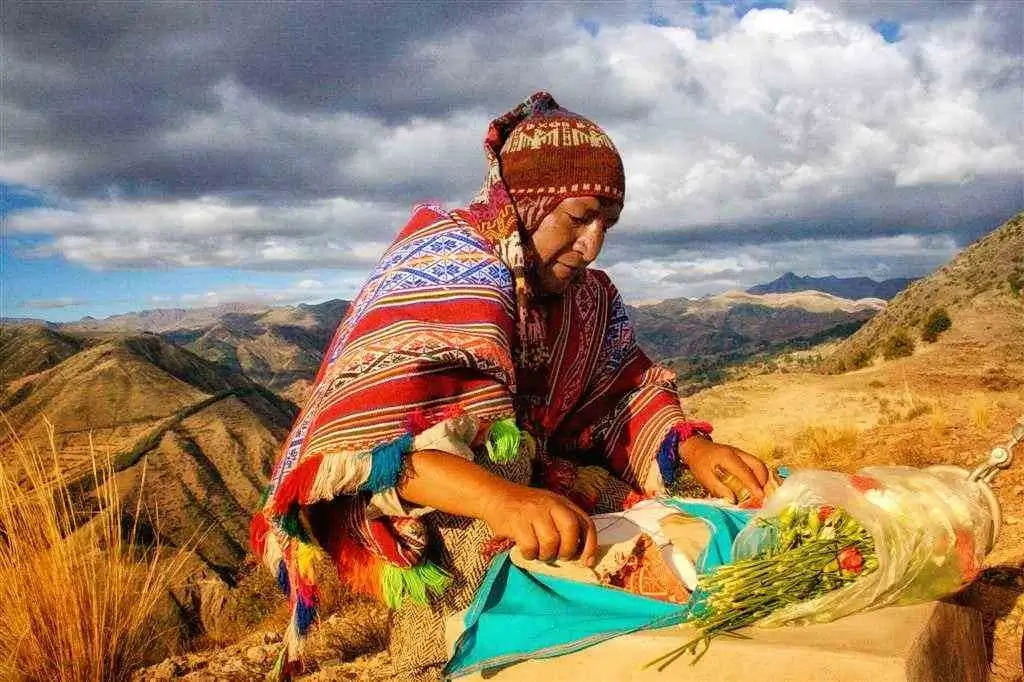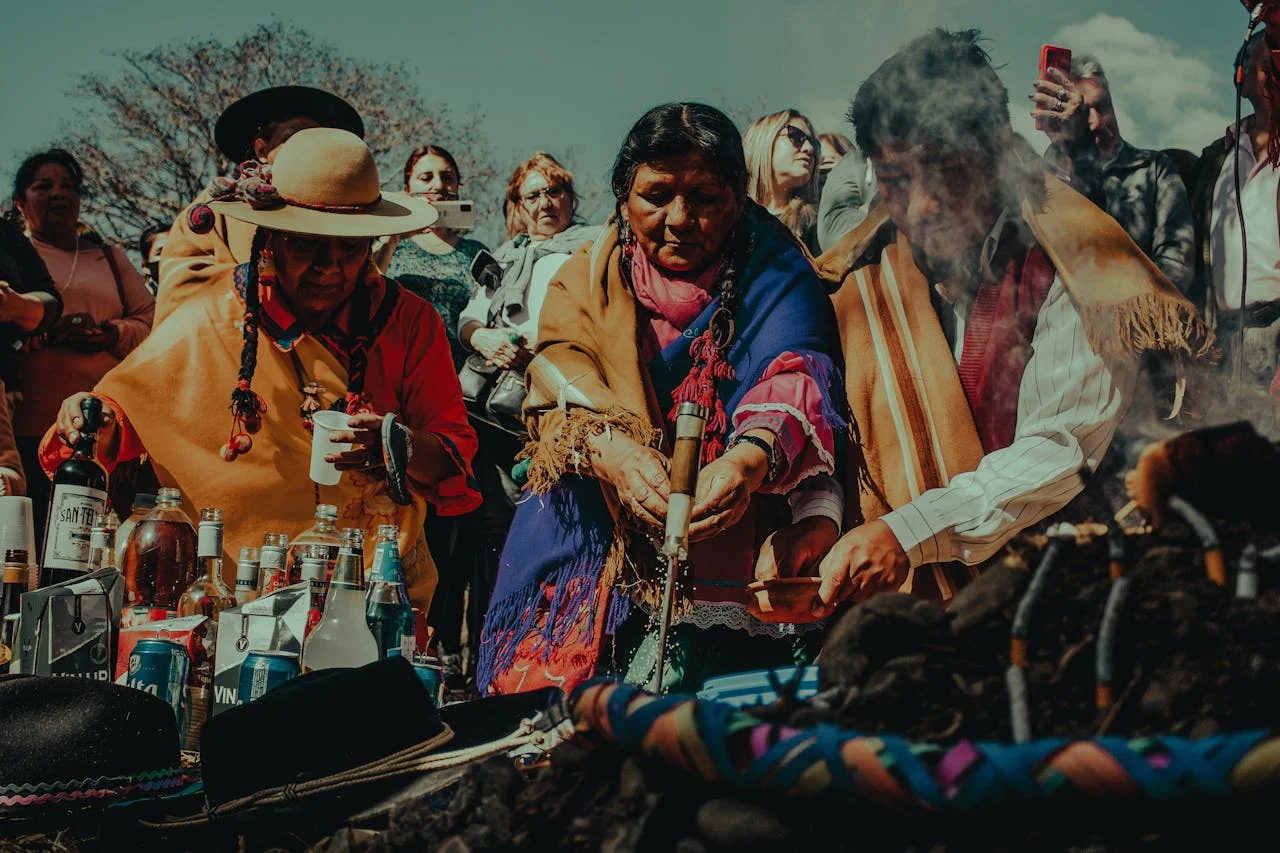One holy festival links people to Pachamama, the source of all life, in the center of the Andes, where rocky peaks kiss the sky and long-standing customs are deeply ingrained. In Andean mythology, Pachamama, also called Mother Earth, is more than just a goddess; she is life itself, providing sustenance and nourishment for all of our necessities.
The Celebración de la Pachamama provides visitors looking for genuine cultural immersion with a unique opportunity to observe a living tradition that balances community, ecology, and spirituality. This festival, which is held every year on August 1st and at significant agricultural events, is an invitation to re-establish connections with the natural world, ourselves, and the ground beneath our feet.
What is Pachamama?
Pachamama, meaning “World Mother” in Quechua and Aymara, is the Incan goddess who embodies the Earth, fertility, mountains, and time. In Andean cosmology, she is a living, breathing force. Every offering to her is a reciprocal act a way of saying "thank you" for the blessings of harvest, health, and harmony.
In today’s Andean communities, worship of Pachamama is ever-present, found in simple daily gestures and grand public ceremonies alike.
Who is Pachamama?
Pachamama is an ancient female deity representing Mother Earth. Her name comes from Quechua, the language of the Incas:
- Pacha = earth, time, or universe
- Mama = mother
She is regarded as the source of food, water, shelter, fertility, and life. Offerings are made to Pachamama, a living being in Andean culture, in order to maintain harmony between nature and humanity. Because she is thought to affect natural occurrences like earthquakes and agricultural cycles, her presence is most revered during the planting and harvesting seasons.
Why August 1st?
Pachamama Day is celebrated every August 1st, marking the beginning of a month when “the earth opens its mouth” to receive thanks and requests. It is the most significant day to perform offerings and rituals, and it’s a powerful moment to reconnect with the natural world.
According to Andean belief, this is when the earth "opens her mouth" — becoming hungry and thirsty. To nourish her, people offer what she has given them: food, drink, and their gratitude.
Main Rituals of Pachamama Raymi:
- Farmers rest their fields on August 1st, allowing the land to breathe.
- Payment to the Earth (Haywasqa) is performed by a Pako.
- Cooked foods are offered, showing respect, and placed in a hole in the ground as an act of feeding Mother Earth.
- Songs and dances are performed in traditional attire with music from Cusco.
Why Is Pachamama Important in Andean Culture?
Pachamama is not just a mythological figure she is a guiding force. Her worship reminds Andean people (and those who visit the region) of the importance of environmental respect, balance, and reciprocity. She teaches us to live in harmony with the earth, appreciating its generosity and giving back in turn.
Where is Pachamama Worshipped?
Pachamama is honored across the Andean highlands, including:
- Peru – Especially in Cusco, Puno, and the Sacred Valley.
- Bolivia – Deeply integrated into everyday life, especially in August.
- Ecuador – Celebrated within Indigenous highland communities.
- Argentina – Most vibrant in Jujuy and Salta provinces.
The Spiritual Significance of the Celebration
The Pachamama Celebration is a highly revered event. It is a time to consider the link between humans and the Earth and is held at the beginning of August, a sacred period that marks the start of the Andean agricultural year. For the Andean people, reciprocity also known as a circle of giving and receiving is the way that life goes.
People congregate in both secluded mountain villages and busy highland cities like Cusco and Huancayo, where spiritual leaders known as paqos or Pampa Misayoc conduct rites from sunrise until sunset.
Rituals and Ceremonies
Pachamama Day is more than a festival it’s a spiritual act of gratitude. It’s a moment to ask for forgiveness for environmental harm, and to renew the collective promise to live in harmony with nature.
These ceremonies are still widely practiced in communities across Peru and Bolivia, and can be experienced on immersive Cusco day tours or cultural trips through the Sacred Valley.
The Significance of the Pachamama Celebration
In Andean cosmology, Pachamama is considered the life-giving force protector of crops, fertility, and all living beings. The Andean worldview is built on reciprocity: the belief that humans must honor and care for the Earth in exchange for her blessings.
Spiritual guides known as Paqos play a key role in these traditions. They possess deep knowledge of sacred rituals and healing practices that are passed down through generations.
Pachamama in the Colonial Era
Spanish conquistadors tried to eradicate native religions when they arrived in the 16th century and replaced them with Catholicism. Churches were constructed on top of sacred temples that had been demolished.
Nonetheless, Inca customs persisted and became part of Catholic imagery. For instance:
- Mountain-like outlines that resembled Apus (holy Andean mountains) started to be used to represent the Virgin Mary.
- Through visual art, the Cusco School of Art (Escuela Cusqueña) preserved the soul of Pachamama by fusing Christian themes with Andean iconography.
Rituals to Pachamama persisted covertly, frequently in obscure or isolated locations, even during the prohibition era.
Pachamama in Inca Times
Pachamama had a strong, supplementary position in the Inca pantheon, even though the Sun God (Inti) was at its center. Her worship was integrated into the larger religion system of the Incas, who brought numerous pre-Inca cultures together.
Pachamama, the female spirit of nature, was revered as the origin of fertility, abundance, and life. The foundation of the Incan economy was agriculture, and success in this sector depended on rituals and tributes to her. Inti, the Sun God, "fertilized" her to guarantee bountiful harvests.
Key Rituals & Practices
The Pago a la Tierra Ceremony
At the heart of the celebration is the Pago a la Tierra, or Payment to the Earth. This ancient ceremony involves despachos beautifully arranged offerings of coca leaves, grains, flowers, sweets, and miniature figurines representing dreams or prayers.
Performed in Quechua or Aymara, the ceremony is led by a shaman or paqo, who invokes Pachamama’s blessings for health, good harvests, and protection. These ceremonies can take place in the Sacred Valley, on mountaintops, or near lakes, creating powerful, immersive experiences for travelers.
Travel Tip: Join our Sacred Valley Cusco Tours or visit a traditional community in Huilloc to witness an authentic despacho ceremony.
Rituals and Offerings: What’s in a “Pago” or “Despacho”?
- These offerings are made with deep symbolism. Every element carries a specific meaning:
- Coca Leaves: Considered sacred; they open a spiritual channel between humans and Pachamama.
- Food: Corn, quinoa, potatoes symbols of nourishment and gratitude.
- Drinks: Wine and chicha are poured into the earth as libations.
- Incense and Herbs: Used to purify the ritual space and send intentions skyward.
- Candies and Miniatures: Represent sweetness, dreams, and prosperity.
Community Feasts & Traditional Cuisine
Following rituals, communities gather for a grand communal feast featuring seasonal foods grown on Pachamama’s soil. The highlight is often the Pachamanca, a traditional Peruvian dish cooked underground using hot stones.
Featured Experience: Savor a traditional Pachamanca as part of our Peru Culture Tour or Sacred Valley Day Trip, prepared alongside local families who share the meaning behind each ingredient.
How Pachamama is Celebrated in 2025
The Pachamama Celebration is held annually on August 1st, marking the beginning of the Andean agricultural year. Ceremonies typically begin at dawn and continue throughout the day with rituals that reflect both ancient traditions and evolving environmental consciousness.
Offerings to Pachamama
Known as pagos or despachos, these offerings include symbolic items like coca leaves, flowers, grains, and small figurines. Led by spiritual leaders (Pampa Misayoc or Paqos), these rituals are performed in Quechua or Aymara, and may also occur during key agricultural milestones like sowing and harvest seasons.
One of the most powerful symbols in these ceremonies is the Chacana, or Andean Cross, representing the interconnected realms of the Andean cosmos.
Cleansing Rituals
Limpias, or energy-cleansing rituals, are performed using flower petals, sacred herbs, and water to purify body and spirit. The despacho ceremony is believed to restore harmony to people, places, and energies. Curious travelers can experience this ceremony as part of a Machu Picchu or Sacred Valley tour.
Traditional Music & Dance
Festivities are filled with Andean music and dance, creating a joyful, communal energy. Instruments like the panpipe, charango, and drums accompany celebratory dances that symbolize unity and reverence for nature.
Community Feast
After the spiritual rituals, a communal feast brings everyone together. The traditional dish Pachamanca a meal prepared in an earth oven with hot stones features meats, potatoes, herbs, and vegetables, representing the bounty of Pachamama.
Sustainability Awareness
Today, the celebration also carries a strong message about environmental conservation. Events and workshops highlight sustainable practices and traditional farming techniques like those preserved in the Potato Park near Cusco.
Sustainability & Modern Meaning
In modern times, the Pachamama Celebration has transformed into a powerful platform for raising environmental awareness and promoting sustainable living. Communities now use this day to highlight practices like organic farming, reforestation, and ecological stewardship.
Initiatives such as the Potato Park near Cusco showcase ancestral agricultural wisdom as a vital tool in the fight against climate change and in preserving biodiversity.
🌿 Why It Matters: The core values of Pachamama balance, respect, and reciprocity serve as timeless principles guiding sustainable tourism and mindful travel.
- Get to know more about the Festivities and Holidays in Peru in our blog.
In an age where fast-paced living often disconnects us from what truly matters, the Celebration of Pachamama offers a powerful reminder: we are not separate from nature we are an intrinsic part of it. This ancestral ritual is not just a cultural experience; it’s an invitation to pause, reflect, and realign with the rhythms of the Earth. Witnessing this celebration is to witness the harmony between humans and the natural world, a harmony we desperately need to restore.
Let your journey be more than a vacation make it a reconnection.
With Andean Travel Experience, discover the sacred places where Earth and spirit become one. Walk ancient paths, listen to the wisdom of the land, and travel not just for the sights but for the soul.
Ready to experience Pachamama? Start planning your journey.





